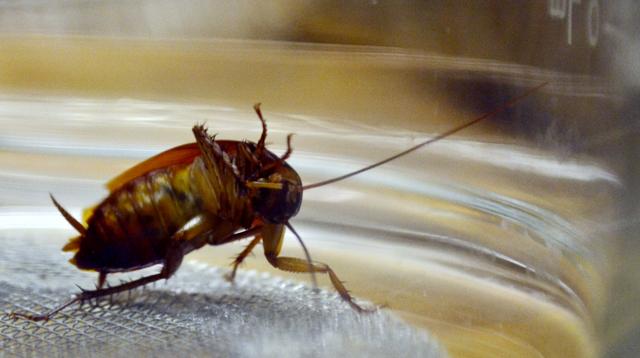 " />
" />
One of distinguished entomology professor Dr. Coby Schal's American cockroaches twists into an acrobatic position as she grooms herself on Feb. 18. When they feel they are in a safe environment, cockroaches frequently pause to groom. While in groups, the insects tend to squabble "like children on a school bus", says Dr. Schal. Photo by Georgia Hobbs
The cockroach has long been a favorite research subject among entomologists. Historically, entomologists prized the creature’s size and availability, which made them ideal candidates before research could be carried out at the microscopic level.
The cockroach still remains a popular subject of study thanks to their decentralized nervous systems and unique appendages, even though the fruit fly has toppled the cockroach’s place and become the favored model for research.
Now, thanks to research done by Coby Schal, a professor of entomology, the self-cleaning habit of cockroaches has opened new avenues for study and potential pest control options.
Schal’s research revolves around the cuticular lipids cockroaches produce on their bodies, which has been an area of interest for many years.
“[The lipids] function in preventing water loss,” Schal said. “When we transport apples, we put the wax on there to prevent them from losing water. The cockroach does the same with its own body. This prevents the cockroach from losing water in a humid environment.”
The waxes that cockroaches form, some as sex pheromones, are incredibly multifaceted and serve several purposes among insects.
The current subject of Schal’s cockroach research came from an observation made by one of his collaborators in Russia. As part of an experiment, researchers immobilized a cockroach for several hours.
“She noticed that the antenna collected a shiny secretion on them,” Schal said. “We immediately suspected the waxes.”
In exploring the buildup, Schal and his colleagues paid a great deal of attention to the cleaning habits of the cockroach. What they found was that the insect would constantly use its mouth to clean off its antennae and legs of the lipids.
“All of this grooming activity ends up in the mouth,” Schal said. “It’s a terrible way to clean yourself. Imagine taking all the water from the shower and drinking it. That’s what a cockroach does.”
Schal said that one of the things that make the research he has been working on easy to understand is that it is relatable to human life.
“It’s so easy to understand and relate to it,” Schal said. “We clean our sensory structures as well. These are fairly simple experiments that result in really cool results.”
One result that has been a focus in the media is the potential of creating more effective pesticide products for extermination efforts. “One of the things that we would argue for is to move away from spray-type insecticides and move more towards powders and dusts,” Schal said. “If we use insecticides in a way that makes them groom it off of their bodies, it’ll be more effective. If we use a powder that becomes stuck to their body, they will be more likely to ingest it.”
Schal’s greatest interest lies in the possibility for future academic angles that the research paves the way for. “One angle we want to take is to generalize it to different insects. We want to see how different insects remove these hydrocarbons form their bodies. We have really strong evidence that this extends to other senses, such as taste. They have these other sensors on the mouth that they groom as much as the antennae.”
Schal said that one goal is to get a better understanding on why cockroaches spend up to 50 percent of their time grooming themselves.
“Why is it so important that cockroach does this? Hopefully in the future once we understand the function, maybe we can interfere in the genetic function, though this is a very long term goal.”